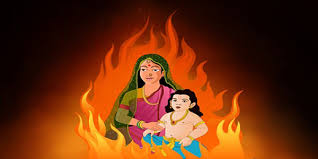Holi Celebration
Why do we celebrate Holi in India?
Several stories are associated with the beginning of Holi in India. The colorful festival brings people together, forgetting their races, religions, castes, and languages. However, various stories are the root cause of the festival's pioneering. Let us check the stories individually and tell me which suits you.
Prahlad and Holika

One of the prevalent stories about the Holi celebration is the triumph story of good over bad. Many years ago, there was a demon king, Hiranyakashipu. He declared himself as the God. On the contrary, his 12 or 13-year-old kid was a firm devotee of Lord Vishnu. Hiranyakashipu made multiple attempts to turn his son away from Lord Vishnu, all in vain.
Finally, he asked his sister, Holika, who meditated for years to win the fire. Hiranyakashipu thought that Holika would resist fire, and Prahlad would turn into ashes. On the full moon day, Holika sat on fire with her nephew in her lap. In contrast, Holika turned into ashes, while Prahlad called Lord Vishnu to win over the fire.
After that day, Holika Dahan is done, a day before the celebration of colors.
Radha and Krishna
In Vrindavan, the Holi celebration is connected to Lord Radha and Krishna. It is a festival linked with the naughtiness and friendships between Krishna and his friends. As he grew older, he fell in love with Radha. He used to play flute and dance with Radha during the Holi festival. All gopis or milkmaids used to surround them enchanted by their divine presence.
There is a story that Krishna was dusky and Radha was fair like milk. He turned jealous so his mother, Yashoda said that apply colours on her face. She will turn like you. He followed his mother’s directions. Thus, the beauty of the Holi celebration started.
Shiva and Kamadeva
Another story is concerning Lord Shiva. Once Kamadev, or the lord of love, lust, and attraction. Once he threw a love bow towards Lord Shiva when he was deep in meditation. Lord Shiva is sweet all the time, but when he enrages, he can turn the whole earth into destruction. Likewise, angered Shiva opened his third eye, and burnt Kamadeva.
The burning of Kamadeva signifies the destruction of lust, ego, and self-admiration.
Raghu and Dhundi
Demoness Dhundi did years of penance to win the blessings of God. She could not be destroyed by humans, animals, cold, or fire. People and sages, in King Raghu’s kingdom, were annoyed by her terrorizing interceptions during pious occasions. Narada Muni advised King Raghu to ask the children to light bonfires and play drums.
The demoness, Dhundi turned annoyed by the children playing drums and bonfires. Automatically, she left the kingdom and turned towards a forest. Nevertheless, she returned to the kingdom again.
Putana
From Lord Krishna’s childhood stories, one is related to the Putana demoness. Krishna’s maternal uncle, Kansa sent a demoness, Putana to kill Krishna. As per the declaration from the lords, the eighth son of Devki, Kansa’s sister would kill him. So he sent several demons and demonesses to end Krishna’s life.
Putana disguised herself as a beautiful lady and tried to feed Krishna poisoned milk. Contrary to the situation, Putana was killed by little Krishna and that day is celebrated as the festival of colors, Holi.
Spring
Holi in India symbolizes the welcoming of the Spring season. It is the advent of new life, new hopes, and new resolutions. Indian farmers celebrate the day after the period of harvesting. The celebration brings the farmers together to rejoice and rejuvenate. Thus, Holi welcomes our connection with nature.
It symbolizes the cycle of life goes round and round. It brings out the beauty of nature through flowers and fruits. Several people now create colors with flowers, fruits and vegetables to develop natural colors that are safe and healthy for everyone.








Comments
Post a Comment